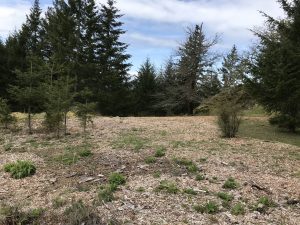Winter 2022-2023
-
- Mulching the restoration area:
Mulching continues through the winter. It is proving to be a tremendous job, but, luckily, we have sufficient wood chips. Hopefully mulching can be finished in time to spread meadow plant seeds in the spring.
Spring 2023
-
- Mulching the restoration area:
Mulching is complete.
As seen in the photographs below, it is noted that the small Douglas Fir trees that existed on the edge of, or within, the Broom forest area have thrived since the Broom removal. As of April 2023, they now ranging in height from 4 ft tall to approximately 10 to 15 ft tall (See Figures P1 and P2). Also evident in these photographs are mature Douglas Fir trees, Ocean Spray, and Garry Oaks.
Figure P1: A Photographed view of the ~ 3000 sq ft restoration area looking SE, April, 2023
Figure P2: A photographed view of the ~ 3000 sq ft restoration area looking NW, April 2023
Unfortunately, by the end of May and beginning of June 2023, thousands of Broom seedlings were observed throughout the mulched area.
It is evident that a 2″ layer of mulch is not sufficient to suppress the germination of Broom seeds. Most Broom seedlings are evident in the mulched areas, rather than, for example, the perimeter of the study area. Also observed in June 2023 are many grasses (not yet sure if these are natives or exotics), about 20 Foxgloves (which are exotic but not invasive), and a small number of thistles. The Foxgloves have not been removed. The Thistles are invasive and have been removed.
Interestingly, a pair of Common Night Hawks (a species in steep decline) has decided to nest at the edge of the restoration area, close to the Garry Oak trees. See more on these observations in the Year 2 results section.
-
- Spreading Seeds
No seeds were distributed in the Spring of 2023, as it was determined that the best time of year to spread native seeds in the late fall.
Summer/Fall 2023
Hundreds of Broom seedlings did not survive the dry summer. However hundreds more did and are thriving now that the Fall rain has arrived. These seedlings continue to be removed. It is estimated that, in the fall of 2023, about 20 hours was spent pulling Broom seedlings.
In addition to spring flowering plants, native grasses and sedges are important parts of an authentic Garry Oak Meadow. If the restoration area is protected from browsing deer, then native plants will naturally germinate in the area over several years. But they will battle it out with non-native grass species such as orchard grass and sweet vernal grass. So to help establish a strong population of native plants, hundreds of native specimens will be planted.
In preparation for planting the natives in the restoration area, the following steps are underway:
- research and identify native grasses and sedges;
- Native grasses and sedges, and other native meadow plants are available at local nurseries. However they are expensive (sometimes as much as $10/4inch pot). It is estimated that thousands of grass seeds and hundreds of other plants will be needed for successful restoration. Therefore we need to:
- identify the native meadow plants growing on areas close to the restoration area,
- harvest and store seeds from the identified grasses and sedges
- sow the collected seeds in pots
- plant the resulting potted seedlings in the restoration area.


